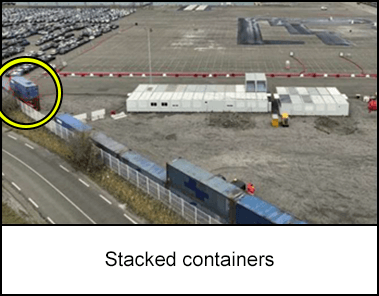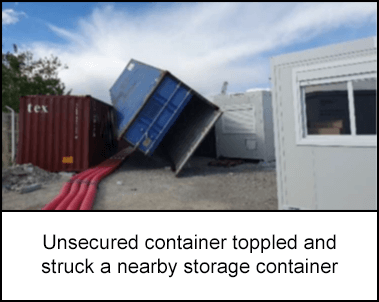-
What happened?
A team on the quay observed a mini tornado heading towards the offices and parking area.
Shortly after, a loud sound was heard by personnel in the nearby office.
An empty 12.5 metres (40 feet) container weighing 3.6 tons (7935 lbs.), previously stacked at a height, toppled and struck a nearby storage container.
Fortunately, no one was in close proximity at the time, resulting in no injuries.
The incident only caused damage to the dropped container itself.

-
Why did it happen?
Adverse weather conditions: The mini tornado was not forecasted or anticipated.
Initial ground storage: The container was initially stored on the ground and later stacked to create additional space as per site requirements.
Lack of securing: The container was not properly secured.
Limited knowledge of stacking risks: There was insufficient awareness of the potential risks associated with stacking containers.

-
What did they learn?
Stacking should be avoided if possible.
Units should only be stacked if:
- are of compatible size and designed for stacking;
- are equipped with suitable cargo restraining;
- lashing devices are properly implemented taking into consideration the load, weight, centre of gravity, and weather conditions.
Conduct regular site safety walkarounds with a focus on safe storage practices and sea-fastening arrangements.
It is essential to request weather forecasters to highlight specific alerts, including potential adverse weather events that project worksites may be exposed to.

-
Ask yourself or your crew
What measures can we implement to improve the safe storage practices of containers, especially in potentially hazardous weather conditions?
What are the additional criteria or guidelines we should establish for the stacking of containers to enhance safety?
How can we ensure that adverse weather events like mini tornadoes are better accounted for in our project planning?
How can we enhance our team's awareness and understanding of the risks associated with stacking containers?

Add to homescreen
Content name
Select existing category:
Content name
New collection
Edit collection
What happened?
A team on the quay observed a mini tornado heading towards the offices and parking area.
Shortly after, a loud sound was heard by personnel in the nearby office.
An empty 12.5 metres (40 feet) container weighing 3.6 tons (7935 lbs.), previously stacked at a height, toppled and struck a nearby storage container.
Fortunately, no one was in close proximity at the time, resulting in no injuries.
The incident only caused damage to the dropped container itself.

Why did it happen?
Adverse weather conditions: The mini tornado was not forecasted or anticipated.
Initial ground storage: The container was initially stored on the ground and later stacked to create additional space as per site requirements.
Lack of securing: The container was not properly secured.
Limited knowledge of stacking risks: There was insufficient awareness of the potential risks associated with stacking containers.

What did they learn?
Stacking should be avoided if possible.
Units should only be stacked if:
- are of compatible size and designed for stacking;
- are equipped with suitable cargo restraining;
- lashing devices are properly implemented taking into consideration the load, weight, centre of gravity, and weather conditions.
Conduct regular site safety walkarounds with a focus on safe storage practices and sea-fastening arrangements.
It is essential to request weather forecasters to highlight specific alerts, including potential adverse weather events that project worksites may be exposed to.
Ask yourself or your crew
What measures can we implement to improve the safe storage practices of containers, especially in potentially hazardous weather conditions?
What are the additional criteria or guidelines we should establish for the stacking of containers to enhance safety?
How can we ensure that adverse weather events like mini tornadoes are better accounted for in our project planning?
How can we enhance our team's awareness and understanding of the risks associated with stacking containers?
An empty 12.5 metres (40 feet) container weighing 3.6 tons (7935 lbs.), previously stacked at a height, toppled and struck a nearby storage container. Fortunately, no one was in close proximity at the time, resulting in no injuries.














